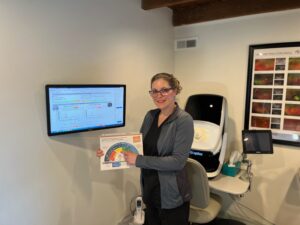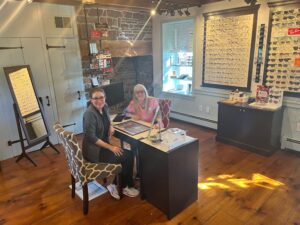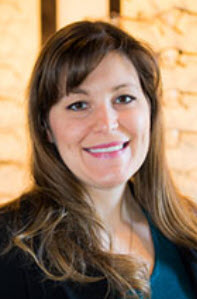
Dr. Richard in one of her exam rooms offering an education on the impact of harmful blue light on the eyes. Dr. Richard is in the process of growing her dry eye and AMD services and related sales, including nutraceuticals.
By Melissa Richard, OD
May 10, 2023
Setting practice goals can ensure you stay on track to continually improve patient care and profitability. Here are three goals my team and I are in the process of working toward this year. By year’s end, I project that reaching these goals will change how we care for patients and grow our patient base and profitability.
Build a Successful Dry Eye Clinic
We’re seeing an increase in patients suffering from dry eye, not only in current patients, but also in those who are seeking treatment online. I’ve been adding dry eye technology to my practice over the past few years: low-level light therapy, TearCare and OptiLight intense pulsed light therapy.
I have also added diagnostic technology including the Marco Phoenix with a meibography workstation. We offer Optase products and stock them in the office. I wanted to create a protocol so I could make the right recommendations for my patients and ensure they feel like they are getting the best, most advanced care.
To reach this goal:
We created patient handouts. The first goes over home care for dry eye. It includes a heat step, a cleansing step and a lubricating step. Each category has options, like hypochlorous acid spray or tea tree oil wipes, and I just check off what I recommend for the patient. This is given out at their comprehensive visit if they have complaints, or at their first dry eye evaluation if they’re coming from outside the practice.
The patient takes the checklist to the front desk where the recommended Optase products are dispensed. We then schedule them for a one-month follow-up to check their progress and compliance. If they’re still suffering at that visit, they get the second handout, a list of additional treatments including LLLT, TearCare and IPL; prescription medications; punctal plugs/cautery (our oculoplastic surgeon does punctal cautery in the office). If they choose LLLT, TearCare or OptiLight IPL, they meet with my practice administrator to go over cost, scheduling and consent forms. They get a nice folder with information on the treatment and what to expect.
We altered the schedule to include a few extra slots a week to conduct dry eye evaluations. These include testing on the Phoenix Meibography Workstation so patients can see their results. We added two half days a month to do IPL treatments in the second exam room.
- We added a page to the website specifically on dry eye and OptiLight.
- We did a three-month marketing program with Marketing4ECPs. They created social media posts and e-mail blasts about our practice and dry eye services.
I already had the Marco Phoenix, LLLT, TearCare and OptiLight. I purchased all of them with a significant Vision Source discount. We also purchased the Optase products with Vision Source reduced pricing. The LLLT costs me about $27 per treatment for the light mask, and the TearCare costs us about $300 per treatment. The patient pays out-of-pocket for the treatments. I got the three-month marketing program with marketing4ecps for free when I purchased the OptiLight. This was an excellent program that drove new patients to the office and got the attention of existing patients.
The doctor is trained on the IPL via one-day training by the company the OptiLight manufacturer, Lumenis. The technicians are trained to do the other treatments by the sales reps. All staff was trained on scheduling. I offered treatments to staff so they could help articulate to our patients what to expect.
Projected ROI: My goal is to have two full days per month dedicated to IPL treatments. We started in January with one half day, and by April we were already at two half days, so I think this goal will be achievable by the end of the year. If we reach the goal of two full days a month at eight patients a day on IPL, we will generate an additional $4,800 per month.
If you’re also working toward a goal of expanding your dry eye services, make sure whoever works up the patient is asking about dry eye symptoms and flagging any patients with symptoms so the doctor can continue the conversation. Our handouts seem to help patients accept my treatment recommendations. We also created some in-office displays, which get patients thinking about dry eye products.
Build an Early AMD Center of Excellence
As a low-vision specialist, I see a lot of AMD, but most of them are referred to me by a retina specialist and are already pretty advanced. I was an early adopter of the AdaptDx and upgraded to the AdaptDx Pro in 2020. I want to create a protocol to test more patients, catch AMD early and start patients on appropriate supplements and lifestyle changes before it’s too late.
I set aside one day per month when we have two technicians and only one doctor in the office to be the AMD testing day. We run the AdaptDx Pro screening, RETeval ERG, MPOD (macular pigment optical density), and in some cases, OCT (if they already have a diagnosis of drusen or early AMD). The results of the tests will allow me to put patients in low/medium/high risk of AMD. I can then offer them supplements and will follow-up with them on more frequent intervals for medical visits.
We currently offer Optomap and iWellness OCT screenings with every comprehensive exam. Patients complete a checklist of risk factors for AMD and then opt in or out of the screening tests. Technicians look at the risk factors and will flag patients over age 50 with multiple risk factors like family history of AMD or difficulty seeing at night. I can then have a conversation with them about returning for the advanced testing. I will also bring any patients back with any suspicious retinal findings. In addition, I will offer to see the children of my low vision patients with AMD.
Similar to the dry eye handouts, I have created custom AMD risk factor sheets with recommendations I can check off. It includes AdaptDx, MPOD and RETeval results so patients can track their results over time.
I already have the equipment: AdaptDx Pro, MPOD, OCT, and just purchased the RETeval. I stock some EyePromise supplements, but it’s not necessary to stock them because we can set the patient up online for direct shipment.
Our technicians were trained by the sales reps on the equipment. I plan on setting up a lunch with the EyePromise rep to train the staff on the benefits of the supplements and make sure everyone knows how to set up the patient online for direct shipments.
I can track our supplement sales. I’m looking for a four-times increase in sales. I currently have one day per month set aside for this testing protocol, but as we detect more AMD, and start patients on supplements, I anticipate this being something we do every other week.
Projected ROI: If we sell the supplements at $15/bottle and get three new patients to sign up per day, two days a month (six patients a day), we will conservatively sign up six new patients a month on auto-ship for supplements. Considering auto-ship will help keep patients ordering and prevent them from forgetting to renew, I project we will by month 12 have 72 patients signed up for auto-ship. This will create an additional $1,080 in monthly revenue moving forward.
In addition, the testing is well-reimbursed, so we are making approximately $250 for the testing visits. If we see six patients a day, two days a month, this creates an additional $3,000 a month of revenue.

Dr. Richard with an optician in her optical. She says that she expects sales of Neurolenses to double by the end of the year.
Increase Premium Lens Sales
Every practice owner would like to increase their premium lens sales, but this was a good goal for my practice this year because it’s the first year we have a full-time optician. She’s great at what she does and loves a challenge. Our premium lens is Neurolens.
I got an e-mail in December 2022 from the Neurolens team about a new feature they added to their system which they told me increased patient willingness to purchase by 38 percent. I definitely wanted that, and decided with some incentives in place, that we could beat that number and increase our Neurolens sales by 50 percent. In 2022, our goal was to sell 10 pairs of Neurolenses a month. We averaged eight per month. My new goal for 2023 is 12 per month.
The first step in working toward this goal was to use the new feature from Neurolens. We used to have all patients fill out a physical seven-question symptom survey called the lifestyle index. Based on the results, my technician would decide whether or not to run the Neurolens measurement device (nMD2) on the patient as part of the exam work-up. For 2023, we got rid of the paper version, and now e-mail patients a link to the lifestyle index when we confirm their appointment. If they don’t complete the survey ahead of time, we have a QR code at the front desk that goes to the same link so it can be done in the waiting room.
The results go directly into our nMD2 and Neurolens portal so we can see which patients are symptomatic and should have testing done ahead of time. Once the patient is tested, they get their specific measurement results by text and/or e-mail with interactive graphics and explanations about the benefits of the Neurolens. This allows my optician and I to have a faster, more effective conversation with an informed patient, reduces time in the office and allows patients to share their results with others. It also increased the amount of nMD2 testing we did in the office. The more testing, the more lenses we sell because we’re able to identify more candidates for the lens.
Other Articles to Explore
There was no cost to upgrade to the new online feature. It’s one extra step to e-mail the link to the patient, but we were moving to e-mail confirmations anyway to give patients access to the EHR portal.
We were already trained to use the device, but we recently hired a new technician and decided to set up a staff lunch-and-learn with our Neurolens reps. The reps challenged us with a month-end goal for number of Neurolenses sold with the incentive of a team party. Incentives work really well with my current team.
We keep track of how many Neurolenses we sell a month. In the first quarter of 2023, we averaged 16.6 pairs per month – double last year’s monthly average. We can also track how many tests are being run. We have increased our testing because it’s easier for the technicians when the patient is already registered in our system.
Projected ROI: Selling just four more pairs of Neurolenses a month creates an additional $3,000 per month of additional profit on lenses alone over what we would have made on average with self-pay or vision plan reimbursements. Since we have been averaging eight additional pairs a month, this number will be closer to $6,000 per month.
 Melissa Richard, OD, MS, is the owner of Spectrum Vision in Chalfont, Penn. To contact her: mrichard@spectrumvision.com
Melissa Richard, OD, MS, is the owner of Spectrum Vision in Chalfont, Penn. To contact her: mrichard@spectrumvision.com





















